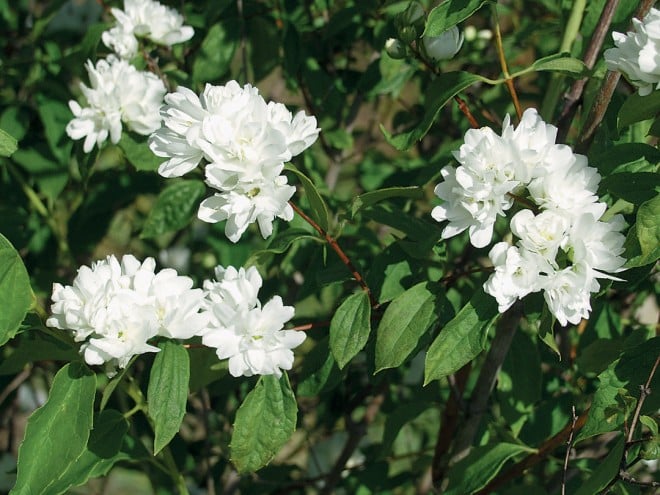
Fragrance in the Wild Western Garden: Philadelphus

Contributor

Toward the realization of a truly interesting, fragrant garden in the American West—one that is meaningful and, especially, osmic—Philadelphus is one of the genera with the most to offer. Western mock orange (Philadelphus lewisii) was collected by the Lewis and Clark Expedition on their return trip through Idaho and Montana in 1806. It is named for Meriwether Lewis. Just one good specimen of this shrub is enough to scent a whole Wild Western garden, all by itself.
However, there is far more to the story. The genus Philadelphus is native to a large swath of land across both North America and Eurasia, stretching, intermittently, from Italy through the Caucasus and Himalayas into China and Siberia and across the sea to Japan. Then it occurs again, on the other side of the Pacific, all the way from Northern California north into British Columbia, east to the Atlantic, and down into Central America. Many of the cultivated species (and their named cultivars) have their origins in China; many more can be found from the deserts of the American West down through the mountains of Mexico, where the genus is outstandingly variable. In isolated, scattered wet places in the Southwest and Mexico, Philadelphus flowers and leaves vary enormously in size; the typically white petals can be centrally marked with purple in some plants. You could spend your whole life trying to figure everything out.
The botanical name of the genus was chosen by Linnaeus, himself, and is but indirectly related to the name of Pennsylvania’s largest city. Linnaeus was, no doubt, aware of the fragrance of the European Philadelphus coronarius. Fragrance surely prompted him in his selection of the name, but he did not record the precise reasons for his choice. The reference could well be to Ptolemy II Philadelphus, the Macedonian king of Egypt. Incense was important in Alexandria, where he decreed the establishment of the great library that housed, in particular, the works of Aristotle.
The sensuous fragrance of Philadelphus coronarius could, as well, have led Linnaeus directly to philadelphus, a word in the Greek vocabulary that has meanings too extreme for some. Here, it may be mentioned that Gerard wrote, in his great Herbal, that its white flowers are too sweet, troubling and molesting the head in a very strange manner. I once gathered the flowers and laid them in my chamber window, which smelled more strongly after they had lain together a few hours, with such an unacquainted favor, that they awaked me out of my sleep, so that I could not take any rest till I had cast them out of my chamber.
Is a good, strong plant of Western mock orange exactly what you need outside your bedroom window? Some plants of this species from west of the Cascades are more weakly scented. Further south and across the mountainous desert, the flowers of littleleaf mock orange (Philadelphus microphyllus) may possess an aroma of Concord grapes. These might be more suited to your fragrant Wild Western garden if it is outside your bedroom window.

Wild Western Mock Oranges
Philadelphus lewisii. Wild mock orange.
This is a common but delightful sight along creeks and hillside seeps in the mountains of northern California [and Oregon, and Washington]. . . . These robust shrubs, growing six to ten feet tall, often produce many strong arching shoots from the base. The main trunks are openly branched, with short, leafy, flowering shoots that appear in late spring or early summer, followed by vegetative branches. Ovate (roughly egg-shaped) leaves up to three inches long are paired along the stems. They are conspicuously veined, often toothed, and painted bright green above, paler beneath.
Showing up beautifully against this backdrop are several- to many-flowered clusters of pure white, usually four-petaled blossoms, which are further decorated by dense central brushes of yellow stamens. The individual flowers measure about an inch, occasionally almost two inches, across and fill the air around them with a delightfully fresh, fruity fragrance. There is considerable variation in every ornamental feature of this species. . . . In the middle 1970s, Ray Collett discovered a bushy plant with fully double flowers near the Smith River and introduced it as ‘Goose Creek’.
Philadelphus microphyllus. Little-leaf mock orange.
This is a smaller shrub, usually under six feet high, and globe-shaped to hemispheric in form. It inhabits rocky sites in the ranges bordering our southern deserts and those of Arizona and Nevada to Texas, though I suspect that its presence indicates more moisture than is obvious at the surface, as it thrives with ordinary irrigation in the landscape.
The flowers are generally, though not always, smaller than those of P. lewisii and borne singly or in few-flowered clusters. A wide variation in fragrance seems to exist among individual clones. My favorite among a batch of Arizonan origin, received from Ginny Hunt, has a delightful perfume suggesting grape and cinnamon candies.
Excerpted from Native Treasures: Gardening with the Plants of California, by M Nevin Smith (UC Press, 2006).
Share:
Social Media
Garden Futurist Podcast
Most Popular
Videos
Topics
Related Posts

Ground Up Science for Greener Cities with Garden Futurist Dr. Alessandro Ossola
Spring 2023 Listen to the Podcast here. Alessandro Ossola is a scientist who gets very excited about the challenge of climate change allowing for an

Readying Urban Forests for Climate Realities with Garden Futurist Dr. Greg McPherson
Winter 2023 Listen to the Podcast here. “Going from the mow and blow to a more horticulturally knowledgeable approach to maintaining the landscape. And that

Welcome, Greywater, to the Garden
Summer 2022 Oh, summer: delightful warm air, tomatoes swelling on the vine, fragrant blooms on an evening stroll. When it’s warm and rainless, how is

Big Tree-Data and Big-Tree Data with Garden Futurist Matt Ritter
Summer 2022 Listen to the full Garden Futurist: Episode XV podcast here. We are in an environmental crisis right now in many parts of California










Responses